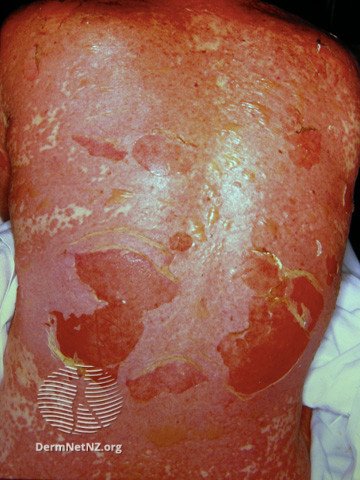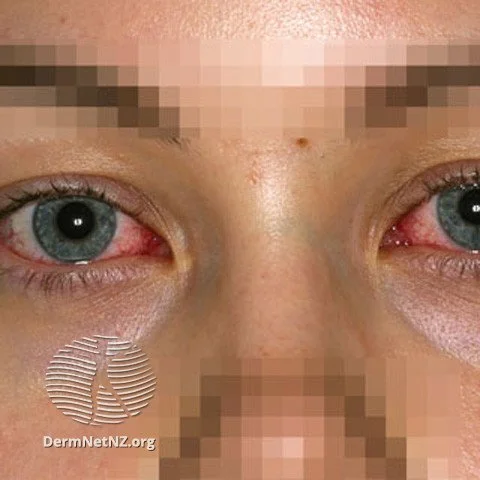
Stevens-Johnson Syndrome/Toxic Epidermal Necrolysis (SJS/TEN)
An example of toxic epidermal necrolysis (TEN), a severe type of drug eruption which can look like a severe burn on the majority of the body.
Credit: DermNet NZ
What is Stevens-Johnson syndrome/toxic epidermal necrolysis (SJS/TEN)?
Stevens–Johnson syndrome (SJS) and toxic epidermal necrolysis (TEN) are rare, severe skin reactions that can be potentially fatal. While they are variants of the same condition, they are distinct from erythema multiforme, typically caused by infections. Key features of SJS/TEN include skin blistering, peeling, and mucous membrane involvement. Patients often experience systemic symptoms such as fever, chills, malaise, and body aches. Immediate medical attention and typically hospitalization in a burn unit are essential due to the severe nature of the condition.
What causes Stevens-Johnson syndrome/toxic epidermal necrolysis (SJS/TEN)?
SJS/TEN results from an uncommon, complex reaction to certain medications, though its exact mechanism is not fully understood. Believed to arise from an abnormal immune system response, medications or occasionally infections are the common triggers. Genetic predispositions might increase the risk of developing SJS/TEN. Notably, an HIV infection significantly elevates the risk. While it's hard to predict its occurrence, some medications have a higher associated risk, including:
Sulfonamide, penicillin, or cephalosporin antibiotics
Various other antibiotics
Anti-convulsants such as lamotrigine, carbamazepine, phenytoin, and phenobarbital
Allopurinol
Acetaminophen
Specific anti-viral medications, particularly nevirapine
NSAIDs, mainly of the oxicam type
In some rare instances, vaccinations
What are the symptoms of Stevens-Johnson syndrome/toxic epidermal necrolysis (SJS/TEN)?
The onset of SJS/TEN is usually within days to a month after initiating a new medication, though anticonvulsants might take up to two months. Prodromal flu-like symptoms often precede the rash and may include fever, body aches, sore throat, red eyes, and cough. The subsequent painful red rash typically starts on the torso, spreading quickly to the face, arms, and legs. The rash can manifest as:
Flat, diffusely red spots
Dark purple patches
Generalized skin redness
Target-like lesions
Blisters, particularly in friction areas
Mucosal areas affected can include:
Eyes: leading to redness, pain, and light sensitivity
Lips and mouth: presenting as red, swollen, crusted lips or painful ulcers
Throat: potentially causing swallowing difficulties
Genital and urinary tract: resulting in ulcers or painful urination
Airways: leading to coughing and breathing challenges
Bowels: potentially causing diarrhea
If you observe multiple of these symptoms post medication initiation, immediate medical consultation is imperative.
How is Stevens-Johnson syndrome/toxic epidermal necrolysis (SJS/TEN) treated?
Due to its life-threatening nature, prompt and comprehensive treatment for SJS/TEN is essential, which includes:
Discontinuation of the suspected medications
Hospitalization, ideally in a burn unit
Utilization of fluid or air-cushioned beds
Intravenous fluid replenishment
Appropriate nutritional support
Maintenance of optimal body temperature, often necessitating a heated room
Pain management
Sterile procedures
Diligent skin care to minimize the risk of infections and further skin damage
Addressing associated symptoms
Considering intravenous steroids, though their use remains debated
How can Stevens-Johnson syndrome/toxic epidermal necrolysis (SJS/TEN) be prevented?
For survivors of SJS/TEN, it's crucial to abstain from the triggering medication and related drugs. If possible, they should also steer clear of:
Anticonvulsants like carbamazepine, phenytoin, lamotrigine, and phenobarbital
Beta-lactam antibiotics such as penicillins, cephalosporins, and carbapenems
NSAIDs
Allopurinol
Sulfonamide antibiotics, including sulfamethoxazole, sulfadiazine, and sulfapyridine
SJS/TEN often involves the mouth, sometimes causing confusion with erythema multiforme.
Credit: DermNet NZ
SJS/TEN can also present with conjunctival injection and redness. It is important to evaluate the eyes, mouth and genital area if suspecting this condition.
Credit: DermNet NZ



